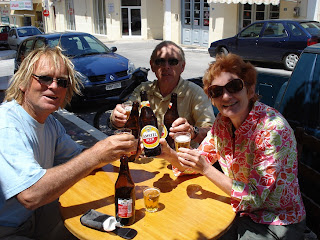Champagne, sparklers and new dreams
As already mentioned in the previous blog, this wonderful voyage of 33,818 nautical miles had taken us six and a half years to complete, and we’d travelled through 39 different countries. We had no home port and no family or friends awaiting us, but we celebrated anyway with a good dinner out. I had magrets de canard (duck breast) for the first time, which the French cook rare, and it was scrumptious.
3 June 2008
After one day at anchor out in the bay, we moved to the Navy Service Marina, lifted Forever out of the water and gave her a good scrubbing down and clean up. The services at the marina were fairly basic but their rates were reasonable and the yard is secure. Within walking distance was the town of Port Saint Louis du Rhône, set right at the mouth of the Rhone River and surrounded by the marshland of the Camargue.
The Rhone
In some places the swarms of mosquitoes were horrendous, but there were some great beaches a cycle ride away, thankfully without mozzies. There weren’t many other liveaboards in the marina but we made a few friends.
Walking the dog with Heiner and Pirkko
Mike’s friend Nick, who had a sister with a holiday home nearby, came to visit for a week. Nick came sailing with us six years earlier in Palma.
Moules Mariniere with Nick, Penny and Peter
Penny and Peter knew something of the area and we all took a marvellous trip to the beautiful historic town of Les Baux de Provence. Most particularly we went to see a spectacular visual display of Van Gogh’s work projected onto the walls of the impressive, now abandoned, limestone quarries in the Val d'Enfer (Hell Valley).
We bought a car and travelled to London, arriving in time for the joint birthday party in July of my two sisters. My brother-in-law, David, produced champagne to celebrate our trip and we were very touched. On the way back we stopped and visited my friend Jane who lives in a small village called Bancel in the Gard area. We attended the local grape harvest fete where the children get to do the first ‘pressing’.
We travelled around by bus, or later in our car, to Arles through the fields of sunflowers that inspired so many of Van Gogh’s paintings, to the charming town of Aix-en-Provence, to the cities of Montpelier and Marseille and through the marshlands of the Camargue to Les-Saintes-Maries-de-la-Mer. We were tourists but also I was looking for work as an English teacher, without success. It seems there were too many better qualified teachers around already, i.e. those who had formal training as ‘teachers’ and not just a TEFL course. My French was/is enough to get by comfortably in social conversation but not nearly adequate enough to do any kind of work other than teaching English. In order to achieve our new dream, it was necessary for me to get some kind of work, but it just wasn’t happening.
The new dream? This is to buy a small property with a bit of land in France (we had discussed Spain, Portugal and Italy but settled on France because of the language) and then live our interpretation of ‘The Good Life’ with our own vegetables and fruit, chickens and ducks, goats and bees. As one friend said ‘Dear God, Peggy, that sounds like the Clampetts!’ Well, yes, perhaps.
The circumnavigation had been Mike’s dream and I had been very happy to be a part of it and help make it come true. The new dream is essentially mine but Mike is equally happy to be a part of it and make it come true. Mike has farmed before in Zimbabwe and South Africa and has good knowledge of poultry and honey bees.
But, unable to find work, we packed up, left Forever settled on the hard at Navy Service and drove back to the UK to find work. Our financial situation hasn’t improved and short of one of us becoming a successful novelist or painter, winning the lottery or robbing a bank our dream remains just that. But we won’t give it up.
And for the immediate future..... this summer we plan to return to France and finally do the trip I so wanted to do three years ago, meandering on the canals through the stunning French countryside from Port Saint Louis du Rhône through Paris and out at Le Havre in the north. I will start a new blog of this trip.
The entrance to the Rhone at Port Saint Louis
You can follow our new blog on the trip (starting April 2011) through the French canals on the following blog: http://riversailing.blogspot.com




















































